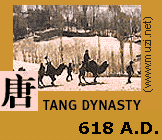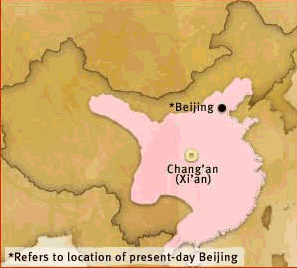 Text: Chapter 5 "A Cosmopolitan
Empire: The Tang Dynasty 581-907"
Text: Chapter 5 "A Cosmopolitan
Empire: The Tang Dynasty 581-907"Sui/Tang
 Text: Chapter 5 "A Cosmopolitan
Empire: The Tang Dynasty 581-907"
Text: Chapter 5 "A Cosmopolitan
Empire: The Tang Dynasty 581-907"
Readings: #25 "Emperor Taizong on Effective Government," #26 "The Tang Legal Code," #26 "The Errors of Geomancy," #28 "The Dancing Horses of Xuanzong's Court," #29 "Family Business," #30 "The Examination System," #31 "A Pilgrim's Visit to the Five Terraces Mountain

CNN's introduction to the Tang period:
Like the Han before it, the rulers of what became the Tang took over from another dynasty, the Sui, which had reunified China. But the Sui fell after only three decades in power.
The Tang was a time of political and cultural sophistication. It established an elaborate examination system for its burgeoning civil service. Buddhism was being absorbed into Chinese society. The arts flourished in China under the Tang -- as did trade with India, Western Asia and, via the "Silk Road," Europe
Sui 581-617 Unification through force of arms, similar to the Qin (p.109)
Tang 618-907 (High point 712-756), Chang'an, the capital, is now the largest city in the world. Contrast Rome: Rome did not rise again except in the form of the Holy Roman Empire, but it was an anomaly.
Political Power
Equal field system continues to be significant
*Divisional militia (volunteer farmer-soldiers) on significance see section, "Maintaining Military Forces," in "Emperor Taizong on Effective Government" and related discussion questions below
What is the relationship between the military and common people's allegiance to the ruler?
What does the emperor say about the ruler taking advice and dealing with (or enfeoffing) relatives?
What did Lu Cai recommend to Emperor Taizong regarding the practice of Geomancy (in "The Errors of Geomancy")?
How are Confucian elements codified into the Tang Legal Code?
Major feats:
*Grand Canal (605-609) Linking Luolang to the Yangzi valley at modern Yangzhou (pp.115-116).
What roles did the Grand Canal play in unifying China?
Cultural/Economic
Cosmopolitan cultivation of arts and music
Tea becomes a major commodity and a common drink
*Chan Buddhism (p.123) will later influence Zen Buddhism in Japan
How is Chan Buddhism different?
To whom might it appeal?
How about other forms of Buddhism like Pure Land and Tantric?
The state supports many monasteries who in turn received many foreign pilgrims and visitors.
How did such support relate to China's tributary relationships with surrounding East Asian countries like Japan and Korea?
What was the economic contribution of monasteries (pp.121-122)?
Decline of the Tang
Last gasps and new hopes